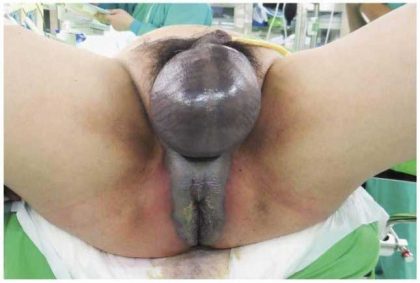- Home
- Editorial
- News
- Practice Guidelines
- Anesthesiology Guidelines
- Cancer Guidelines
- Cardiac Sciences Guidelines
- Critical Care Guidelines
- Dentistry Guidelines
- Dermatology Guidelines
- Diabetes and Endo Guidelines
- Diagnostics Guidelines
- ENT Guidelines
- Featured Practice Guidelines
- Gastroenterology Guidelines
- Geriatrics Guidelines
- Medicine Guidelines
- Nephrology Guidelines
- Neurosciences Guidelines
- Obs and Gynae Guidelines
- Ophthalmology Guidelines
- Orthopaedics Guidelines
- Paediatrics Guidelines
- Psychiatry Guidelines
- Pulmonology Guidelines
- Radiology Guidelines
- Surgery Guidelines
- Urology Guidelines
A rare case of Fournier's Gangrene

Fournier's gangrene is a rare and often fulminant necrotizing fasciitis of the perineum and genital region frequently due to a synergistic polymicrobial infection. This truly life-threatening, an emergent condition is typically seen in elderly, diabetic, or otherwise immune-compromised individuals.
It is more common in men between the age of 50 and 60 years. It is 10 times more likely to occur in men than women and children. Fournier's gangrene is very rare in children.
In the present case, a 46-year-old man with uncontrolled type 2 diabetes and alcoholic liver disease came to the emergency department with painful swelling in the scrotum and perianal region. On examination, his temperature was 37.7°C, his pulse 130 beats per minute, and his blood pressure 97/61 mm Hg.
The physical examination revealed a necrotic-appearing tissue in the scrotum and perineum, with areas of induration and crepitus. The CT, computed tomography revealed subcutaneous emphysema in the scrotum and perianal fascia, in addition to air in the pararectal fascia and rectal wall.
Consequently, a diagnosis of Fournier's gangrene, or necrotizing fasciitis of the perineum, was made.

Courtesy NEJM
The patient underwent prompt laparoscopic-assisted abdominal perineal resection. His pathological analysis revealed multiple gas-filled pockets in necrotic tissue, with neutrophilic infiltration. The patient received fluid resuscitation and broad-spectrum antibiotics after surgery. Approximately 3 weeks after surgery, split-thickness skin grafting was performed for perineum reconstruction after which he was discharged home with a permanent colostomy.
Reference,
https://www.nejm.org/doi/full/10.1056/NEJMicm1609306

Disclaimer: This site is primarily intended for healthcare professionals. Any content/information on this website does not replace the advice of medical and/or health professionals and should not be construed as medical/diagnostic advice/endorsement or prescription. Use of this site is subject to our terms of use, privacy policy, advertisement policy. © 2020 Minerva Medical Treatment Pvt Ltd